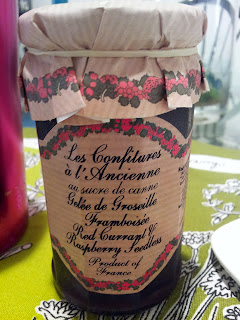Everyday lunch
for a Parisian is, again, a practical affair.
Just like I remember from “the Paris of South America” (i.e. Buenos
Aires), most of the shops and offices allow for a 2-hour lunch break during
which to recharge and have a simple but proper meal. We should adopt this in North America too. I think it will provide for less aggressive
teenagers and stronger families.
But going back to
the theme in question, a very common lunch is that of entrecôte and pommes
frites. In Argentina we add a salad of
lettuce and tomato to this, and a good glass of red wine. I make mine whenever I feel the need for a
nice juicy steak, and I cook it in-between saignant
and à point. This of course, is pure preference, but as I
immerse myself in the ways of proper eating, I find there is something to be
said about meat eaten almost raw, and that is, that carnivores appreciate (or
at least should appreciate) the value of raw meat. A kind of going back to the source, in a way.
Entrecôte Villette:
Ingredients for 1
serving:
- 1 entrecôte (ribsteak), weighing about 10 to 12oz. and no more than ¾” thick
- 5 shallots
- 6 ½ Tbsp. unsalted butter
- Salt and freshly ground pepper
- 1 tsp. finely chopped flat leaf parsley
- Lemon juice
- Fleur de sel
Preparation:
Pepper the meat,
cover and allow it to rest for 2 hours.
Peel and finely
chop the shallots, then heat a third of the butter and brown the lightly salted
entrecôte on each side for a short time.
Remove from the pan and keep warm.
Melt the remaining butter, add the shallots and brown for 2 minutes.
Serve the meat on a warm plate, pour on the
shallots and butter, sprinkle with parsley and add a few drops of lemon
juice. Then add the fleur de sel and
freshly ground pepper to taste. Serve
with French fries.
For the “pommes
frites”:
This method will
yield you crisp, golden fries with a soft center. You will need 1 medium mealy potato, cut into
¼” strips. Once cut, submerge in water
for about 15’. In the meantime, heat
either sunflower or grapeseed oil up to 300F (use a thermometer).
Get the potato
slices out of the water and dry with a tea-towel. Once the oil is hot, dip them for 4 minutes. Take them out and place on a paper towel.
When I am at the
office, I often bring a Croque Monsieur
for lunch. In Argentina we know this as
“sandwich mixto”, and it is served at all hours in any confitería. Here’s the
simple way to make it:
Croque Monsieur:
Ingredients:
- 2 slices of pain de mie, without the crusts
- 1 tsp. unsalted butter
- ½ slice of cooked ham
- 2 Tbsp. finely grated Comté cheese
Preparation:
Thinly spread the butter onto both sides
of the bread. Lay the ham on one slice
and sprinkle on the finely grated cheese.
Cover with the second slice of buttered bread. Preheat the broiler. First broil on one side, then the other.
 |
| A quick bite at my desk. |









